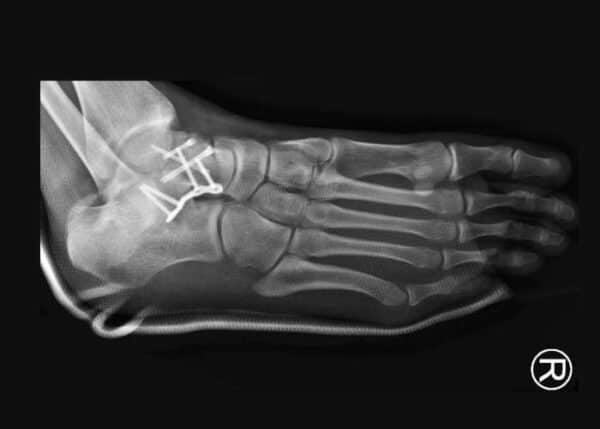Ankle Fracture Repair Surgeons
Ankle fractures can be common in athletes, especially those who participate in contact sports or who jump, twist or land on one foot. If you have suffered a broken ankle or a syndesmosis ankle injury, you should see orthopedic foot and ankle surgeons, Doctors Thomas Haytmanek and Jonathon Backus. They offer non-surgical and surgical treatment options for patients from Vail, Colorado, and the surrounding Eagle, Vail, and Gore Mountain Ranges who have experienced a broken ankle. Contact The Steadman Clinic’s Sports Foot and Ankle team today!

What is an ankle fracture?
The tibia (shin bone), fibula (smaller lower leg bone), and talus (ankle bone) join together to form the ankle joint. The lower ends of the tibia and fibula have bony prominences known as malleoli that serve as attachment points for the ankle ligaments. These bony prominences can break when the ankle joint is twisted or rolled. This is typically from the impact of a ski or snowboard injury, a motor vehicle collision, or a slip and fall on an unstable surface. Occasionally, the syndesmosis (ligamentous juncture between the tibia and fibula) may also be involved in these injuries. An ankle fracture can be a debilitating injury if not addressed correctly.
What is the treatment for an ankle fracture?
Minor ankle fractures that are non-displaced can be successfully treated with conservative treatment measures such as limited weight-bearing in a short leg cast or walking boot. However, more invasive treatment is necessary when there is bony displacement in one or more of the ankle fractures or significant ligamentous damage. Surgical intervention involves implementing metal plates and screws to hold the bony fragments while they heal and often repairing injured ligaments. The goal of stabilizing an unstable ankle fracture is to regain full functionality of the ankle by restoring the correct anatomical bony and ligamentous configuration. Our doctors specialize in ankle fracture repair for patients from Vail, Colorado, and the surrounding Eagle, Vail, and Gore Mountain Ranges.

How is an ankle fracture repair performed?
One of our surgeons will accomplish an ankle fracture repair through a surgical technique known as open reduction and internal fixation (ORIF). This outpatient procedure aims to move the bony fragments back into the correct anatomical alignment. A nerve block is typically administered for anesthesia which can last for several hours to several days after the procedure. During the surgery, the surgeon will create a few small incisions around the ankle fracture site. Similar to a jigsaw puzzle, the bony fragments of the ankle are manually manipulated into the correct anatomical configuration through an open reduction technique. These bony fragments are then internally fixed into position using special plates and screws. Implanting orthopedic hardware ensures the bone fragments will heal in the correct alignment. More severe and/or complex ankle fractures may require implementing more plates and screws to accomplish internal fixation.
How is a syndesmosis injury repaired?
A syndesmosis injury (injury to the juncture between the tibia and fibula near the ankle joint) is also repaired using the open reduction internal fixation technique. The fibula is identified and placed into the correct position in relation to the tibia. This joint is then internally fixed using screws or, more frequently, flexible suture implants to maintain the corrected position.
For some ankle injuries, our surgeons can utilize a surgical device that helps repair a syndesmosis injury of the ankle. This device is made by Arthrex and is called the Syndesmosis TightRope™ Fixation System. You can learn more about the Syndesmosis TightRope™ Fixation System HERE.
What is the recovery period like after an ankle fracture repair?
The recovery period following a successful ankle fracture repair is determined by the severity and complexity of the ankle fracture. The majority of patients in Vail, Colorado, and the surrounding Eagle and Gore Mountain Ranges can anticipate a return to their normal daily and athletic activities in approximately 3 to 4 months; however, healing may take as long as one year for some patients. Immediately following surgery, the ankle is immobilized in a short leg splint. The use of crutches or a knee scooter during the first 2 weeks is recommended. Most patients are transitioned to a CAM walking boot at 2 weeks and allowed to work on range of motion and begin touch down weight bearing. The CAM boot is typically removed to sleep and to shower. At four weeks, most patient begin a two week weight bearing progression making them full weight bearing at 6 weeks in the CAM boot. The key to recovering from ankle fracture repair is adhering to and completing the recommended physical rehabilitation program. This physical therapy program begins approximately 2 weeks following surgery and aims to restore motion and strengthen the repaired ankle joint.
